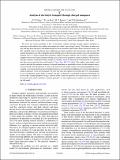| dc.contributor.author | Peters, P. B. | |
| dc.contributor.author | van Roij, R. | |
| dc.contributor.author | Biesheuvel, P. M. | |
| dc.contributor.author | Bazant, Martin Z. | |
| dc.date.accessioned | 2016-05-24T13:23:34Z | |
| dc.date.available | 2016-05-24T13:23:34Z | |
| dc.date.issued | 2016-05 | |
| dc.date.submitted | 2016-04 | |
| dc.identifier.issn | 2470-0045 | |
| dc.identifier.issn | 2470-0053 | |
| dc.identifier.uri | http://hdl.handle.net/1721.1/102652 | |
| dc.description.abstract | We revisit the classical problem of flow of electrolyte solutions through charged capillary nanopores or nanotubes as described by the capillary pore model (also called “space charge” theory). This theory assumes very long and thin pores and uses a one-dimensional flux-force formalism which relates fluxes (electrical current, salt flux, and fluid velocity) and driving forces (difference in electric potential, salt concentration, and pressure). We analyze the general case with overlapping electric double layers in the pore and a nonzero axial salt concentration gradient. The 3 × 3 matrix relating these quantities exhibits Onsager symmetry and we report a significant new simplification for the diagonal element relating axial salt flux to the gradient in chemical potential. We prove that Onsager symmetry is preserved under changes of variables, which we illustrate by transformation to a different flux-force matrix given by Gross and Osterle [J. Chem. Phys. 49, 228 (1968)JCPSA60021-960610.1063/1.1669814]. The capillary pore model is well suited to describe the nonlinear response of charged membranes or nanofluidic devices for electrokinetic energy conversion and water desalination, as long as the transverse ion profiles remain in local quasiequilibrium. As an example, we evaluate electrical power production from a salt concentration difference by reverse electrodialysis, using an efficiency versus power diagram. We show that since the capillary pore model allows for axial gradients in salt concentration, partial loops in current, salt flux, or fluid flow can develop in the pore. Predictions for macroscopic transport properties using a reduced model, where the potential and concentration are assumed to be invariant with radial coordinate (“uniform potential” or “fine capillary pore” model), are close to results of the full model. | en_US |
| dc.description.sponsorship | Stanford University. Global Climate and Energy Project | en_US |
| dc.description.sponsorship | United States. Dept. of Energy. Office of Basic Energy Sciences. SUNCAT Center for Interface Science and Catalysis | en_US |
| dc.publisher | American Physical Society | en_US |
| dc.relation.isversionof | http://dx.doi.org/10.1103/PhysRevE.93.053108 | en_US |
| dc.rights | Article is made available in accordance with the publisher's policy and may be subject to US copyright law. Please refer to the publisher's site for terms of use. | en_US |
| dc.source | American Physical Society | en_US |
| dc.title | Analysis of electrolyte transport through charged nanopores | en_US |
| dc.type | Article | en_US |
| dc.identifier.citation | Peters, P. B., R. van Roij, M. Z. Bazant, and P. M. Biesheuvel. “Analysis of Electrolyte Transport through Charged Nanopores.” Phys. Rev. E 93, no. 5 (May 13, 2016). © 2016 American Physical Society | en_US |
| dc.contributor.department | Massachusetts Institute of Technology. Department of Chemical Engineering | en_US |
| dc.contributor.department | Massachusetts Institute of Technology. Department of Mathematics | en_US |
| dc.contributor.mitauthor | Bazant, Martin Z. | en_US |
| dc.relation.journal | Physical Review E | en_US |
| dc.eprint.version | Final published version | en_US |
| dc.type.uri | http://purl.org/eprint/type/JournalArticle | en_US |
| eprint.status | http://purl.org/eprint/status/PeerReviewed | en_US |
| dc.date.updated | 2016-05-13T22:00:03Z | |
| dc.language.rfc3066 | en | |
| dc.rights.holder | American Physical Society | |
| dspace.orderedauthors | Peters, P. B.; van Roij, R.; Bazant, M. Z.; Biesheuvel, P. M. | en_US |
| dspace.embargo.terms | N | en_US |
| mit.license | PUBLISHER_POLICY | en_US |
| mit.metadata.status | Complete | |
